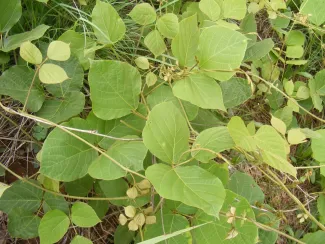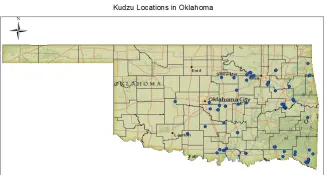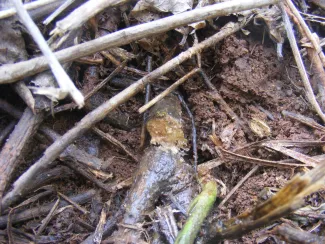Kudzu has long been regarded as a troublesome vine in the southeastern United States, smothering thousands of acres in some areas. Now, even Oklahomans need to keep an eye out for this problematic plant.

Kudzu, which can be misidentified as poison ivy, has brown, hairy stems and leaflets that are hand-sized or larger. (Kyle Johnson/ODWC)
As its “foot-a-night” or “mile-a-minute” nicknames imply, Kudzu grows voraciously, swallowing up acres fast. Few plants survive where the plant invades, especially as time passes. Entire trees can be swarmed, often causing the tree to die and/or fall over.

Kudzu has been documented in several Oklahoma counties. (Map courtesy of Oklahoma State University.)
Tap roots can weigh as much as 200 pounds, and vines that trail along the soil quickly grow new roots for added support and growth. Unfortunately, the size of well-established communities makes these vines very difficult to control.
Thankfully, keeping an eye out for young kudzu outbreaks and taking action early does provide various control options. Goats, sheep, and cattle will repeatedly eat the plant. Control is also achievable through repeated mowing and/or cutting. Both of these measures will help, but neither is likely to eliminate it.
Other control options include the use of herbicides. Kudzu foliage can be repeatedly sprayed during the growing season to defoliate the plant and force it to use its root reserves to regrow new leaves. If only one application is possible, spraying in the fall is best, especially while the leaves are still green.

Applying herbicide immediately to a cut stump is a great way to target the control away from desirable plants that may be nearby. Following all lable directions and precautions is important when using any pesticide product. (Kyle Johnson/ODWC)
When non-target plants are nearby, the cut stump method is recommended. Cutting and carefully treating the root crown with glyphosate, triclopyr, metsulfuron, or aminopyralid will help target the chemical to the root system. Often, foliar and cut stump methods are combined to provide the greatest results, especially since a single vine can have dozens of roots supporting it over a wide area.
Regardless of the method chosen, landowners fighting a battle against kudzu should monitor the site each year and continue with control measures as needed. Ten years may be required before zero plants emerge, especially for well-established communities. In addition, annual inspections are always recommended in any area where kudzu once occurred or occurs nearby.
Technical assistance for kudzu and other noxious weeds is available by contacting the private lands biologist in your region. Invasive plants can be reported at inaturalist.org. Potential kudzu sightings can also be sent to Oklahoma State University’s Karen Hickman at karen.hickman@okstate.edu for verification.